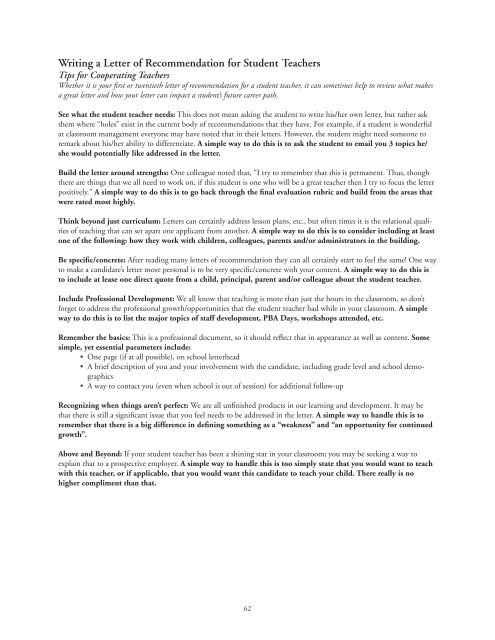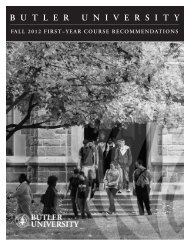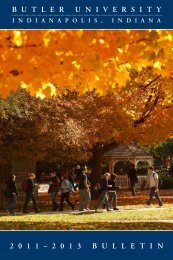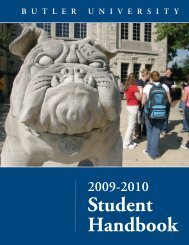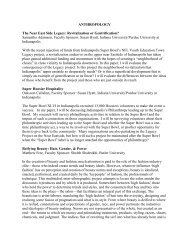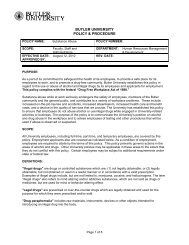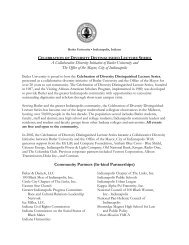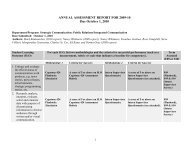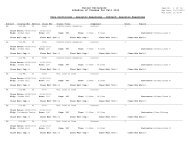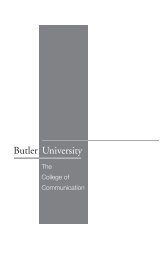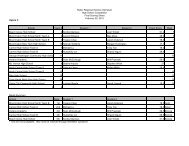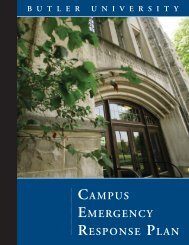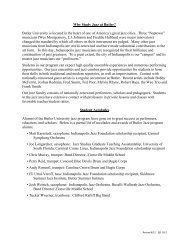Student Teaching Handbook - Butler University
Student Teaching Handbook - Butler University
Student Teaching Handbook - Butler University
You also want an ePaper? Increase the reach of your titles
YUMPU automatically turns print PDFs into web optimized ePapers that Google loves.
Writing a Letter of Recommendation for <strong>Student</strong> Teachers<br />
Tips for Cooperating Teachers<br />
Whether it is your first or twentieth letter of recommendation for a student teacher, it can sometimes help to review what makes<br />
a great letter and how your letter can impact a student’s future career path.<br />
See what the student teacher needs: This does not mean asking the student to write his/her own letter, but rather ask<br />
them where “holes” exist in the current body of recommendations that they have. For example, if a student is wonderful<br />
at classroom management everyone may have noted that in their letters. However, the student might need someone to<br />
remark about his/her ability to differentiate. A simple way to do this is to ask the student to email you 3 topics he/<br />
she would potentially like addressed in the letter.<br />
Build the letter around strengths: One colleague noted that, “I try to remember that this is permanent. Thus, though<br />
there are things that we all need to work on, if this student is one who will be a great teacher then I try to focus the letter<br />
positively.” A simple way to do this is to go back through the final evaluation rubric and build from the areas that<br />
were rated most highly.<br />
Think beyond just curriculum: Letters can certainly address lesson plans, etc., but often times it is the relational qualities<br />
of teaching that can set apart one applicant from another. A simple way to do this is to consider including at least<br />
one of the following: how they work with children, colleagues, parents and/or administrators in the building.<br />
Be specific/concrete: After reading many letters of recommendation they can all certainly start to feel the same! One way<br />
to make a candidate’s letter more personal is to be very specific/concrete with your content. A simple way to do this is<br />
to include at lease one direct quote from a child, principal, parent and/or colleague about the student teacher.<br />
Include Professional Development: We all know that teaching is more than just the hours in the classroom, so don’t<br />
forget to address the professional growth/opportunities that the student teacher had while in your classroom. A simple<br />
way to do this is to list the major topics of staff development, PBA Days, workshops attended, etc.<br />
Remember the basics: This is a professional document, so it should reflect that in appearance as well as content. Some<br />
simple, yet essential parameters include:<br />
• One page (if at all possible), on school letterhead<br />
• A brief description of you and your involvement with the candidate, including grade level and school demographics<br />
• A way to contact you (even when school is out of session) for additional follow-up<br />
Recognizing when things aren’t perfect: We are all unfinished products in our learning and development. It may be<br />
that there is still a significant issue that you feel needs to be addressed in the letter. A simple way to handle this is to<br />
remember that there is a big difference in defining something as a “weakness” and “an opportunity for continued<br />
growth”.<br />
Above and Beyond: If your student teacher has been a shining star in your classroom; you may be seeking a way to<br />
explain that to a prospective employer. A simple way to handle this is too simply state that you would want to teach<br />
with this teacher, or if applicable, that you would want this candidate to teach your child. There really is no<br />
higher compliment than that.<br />
62


